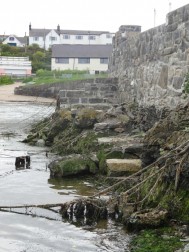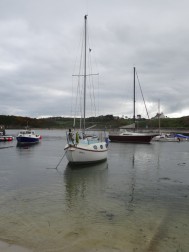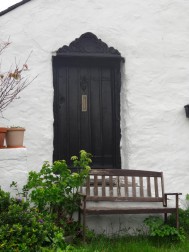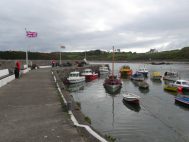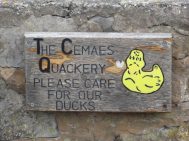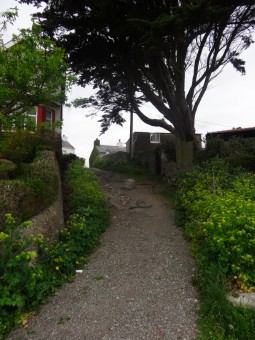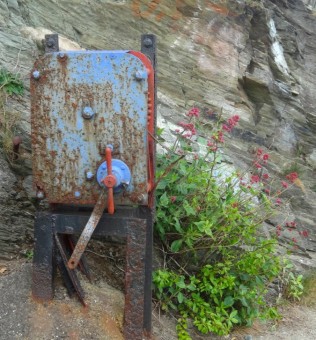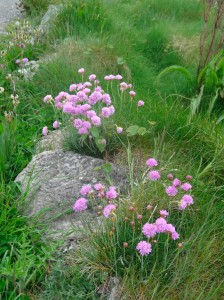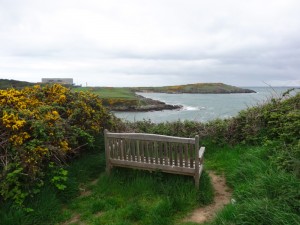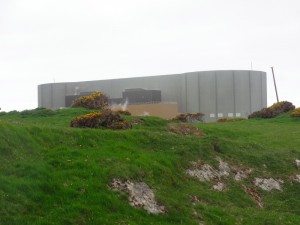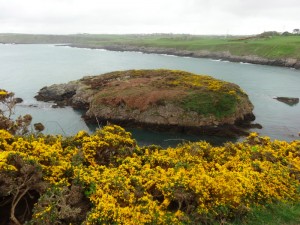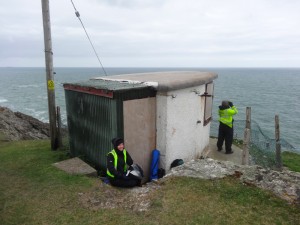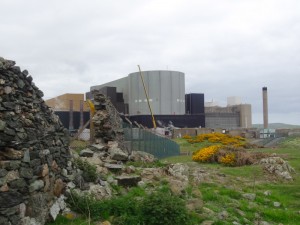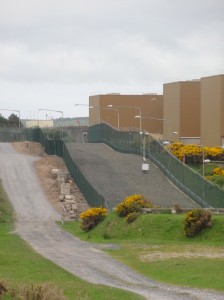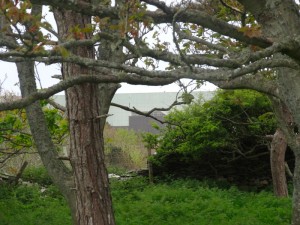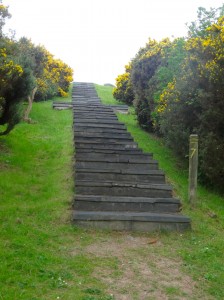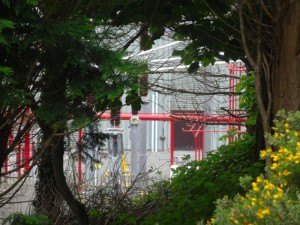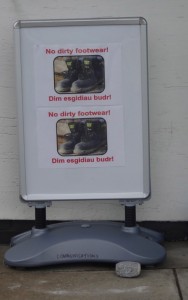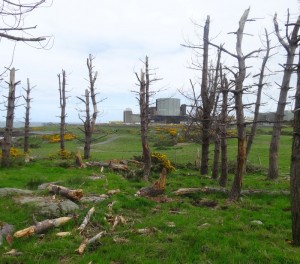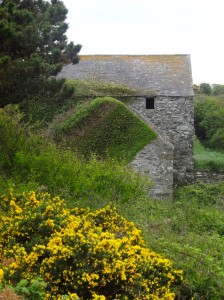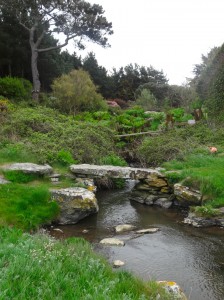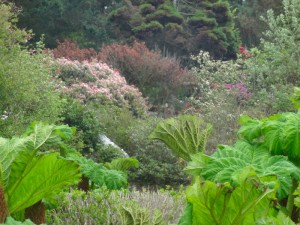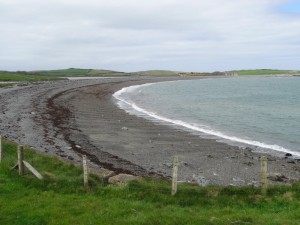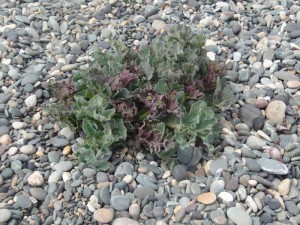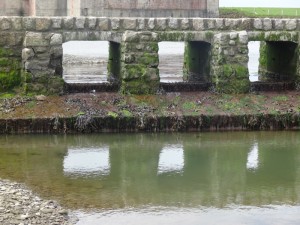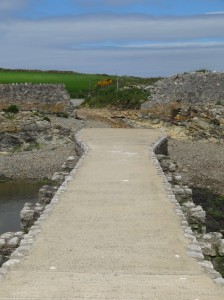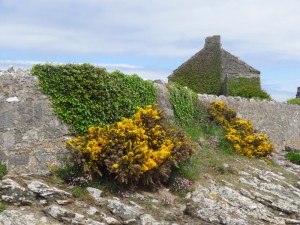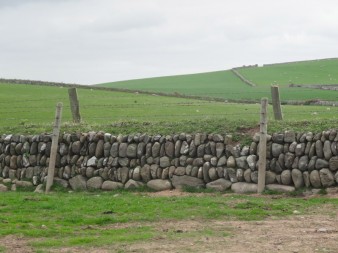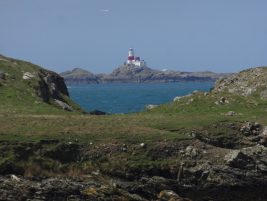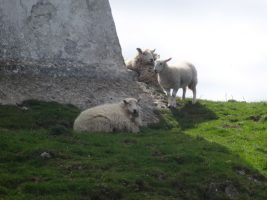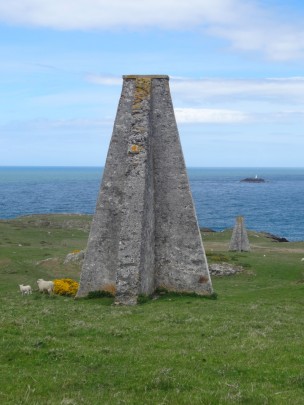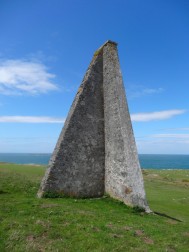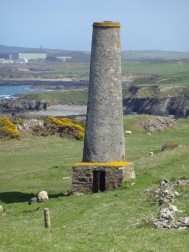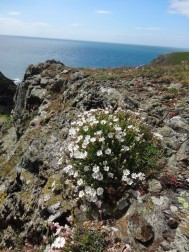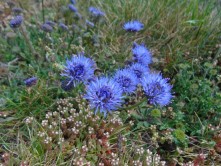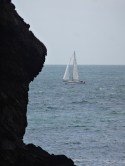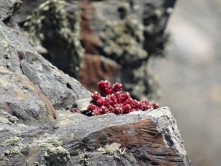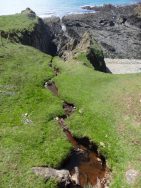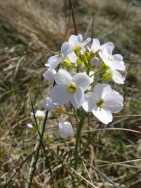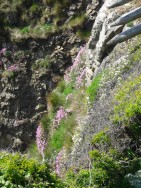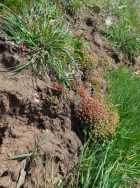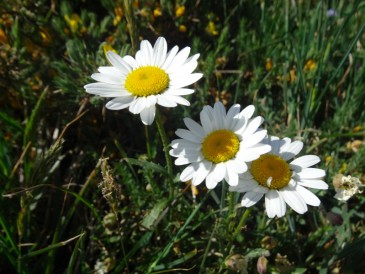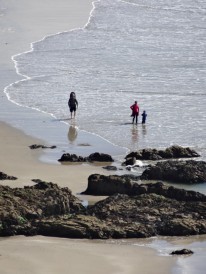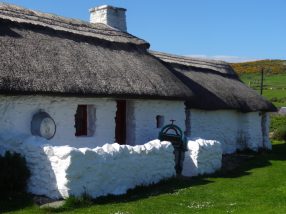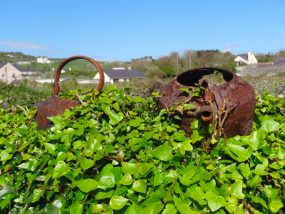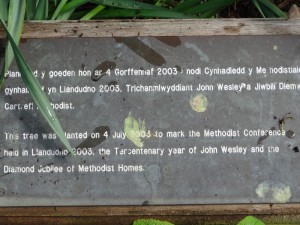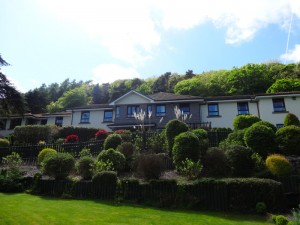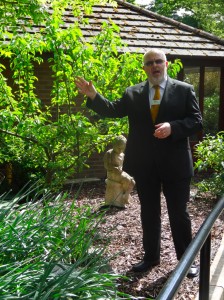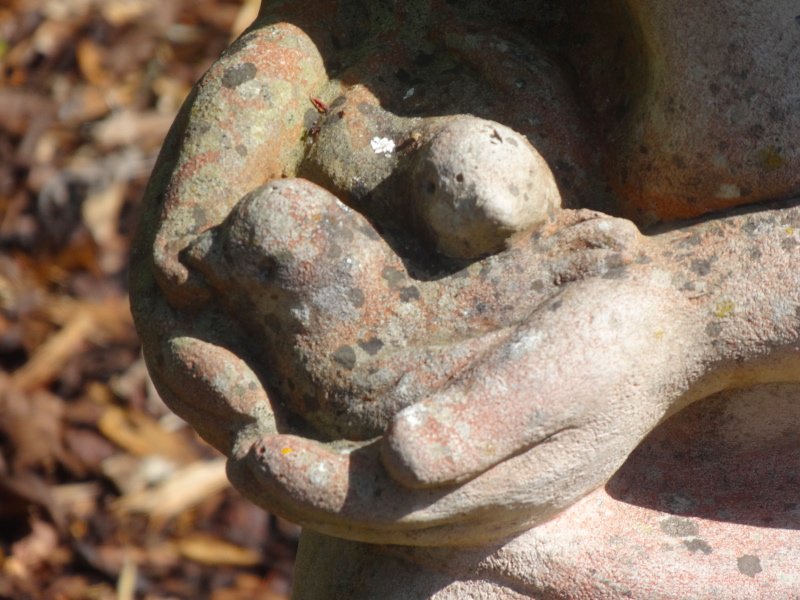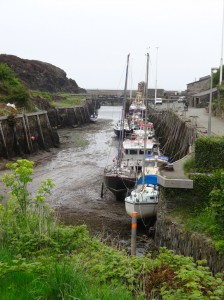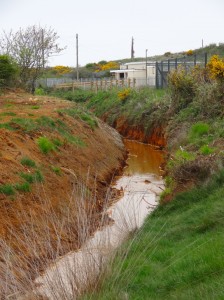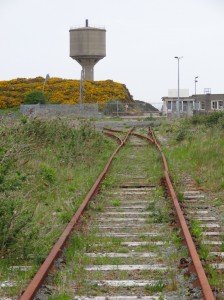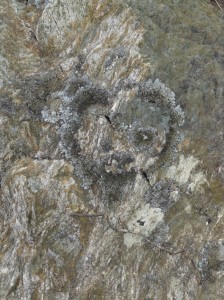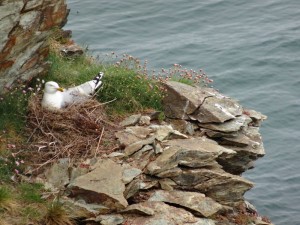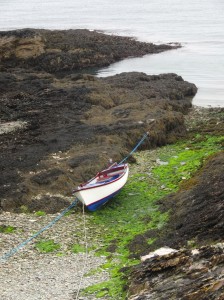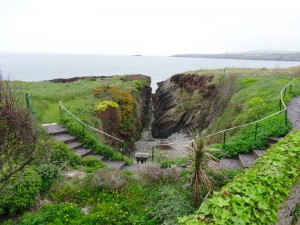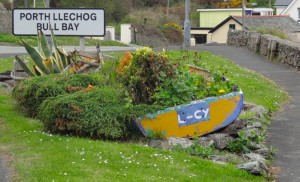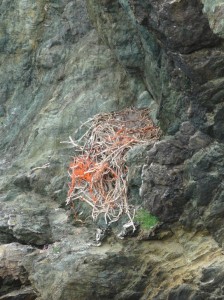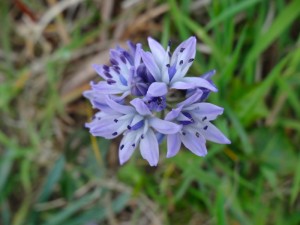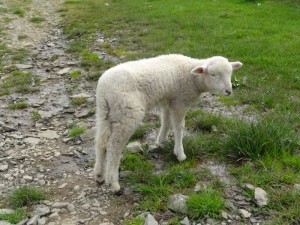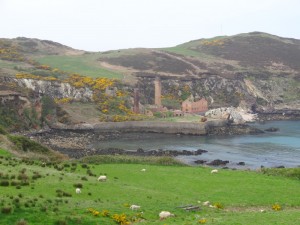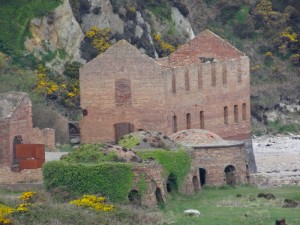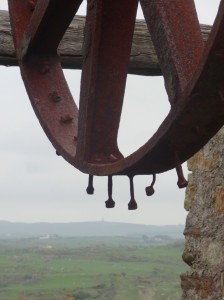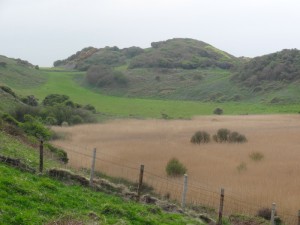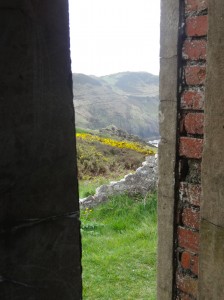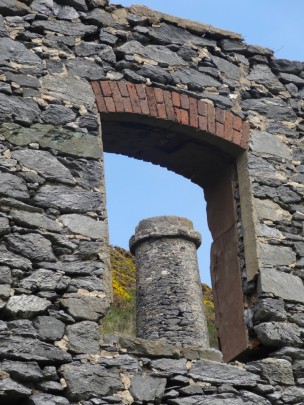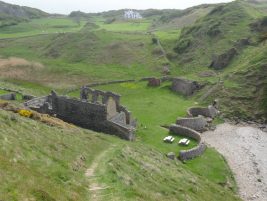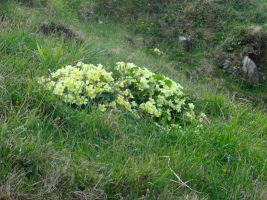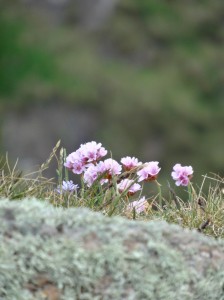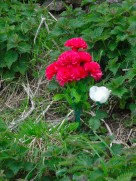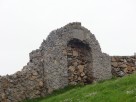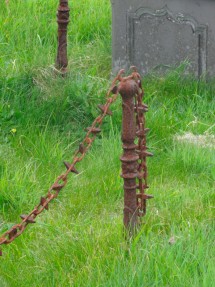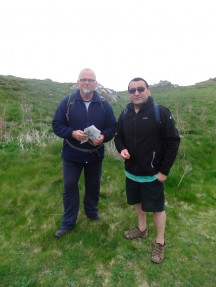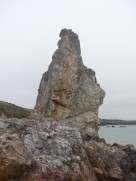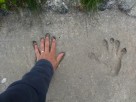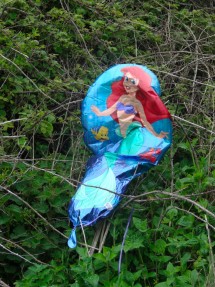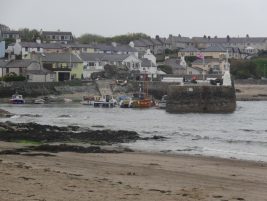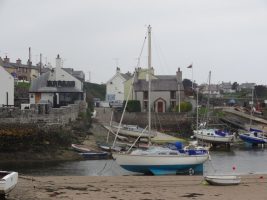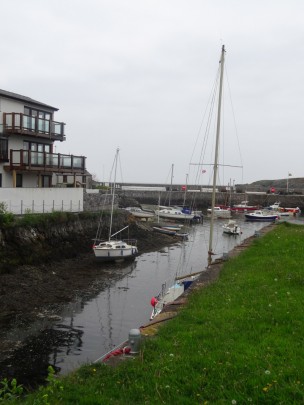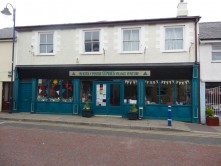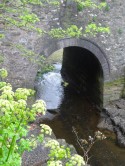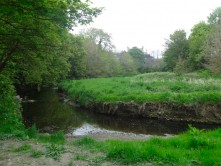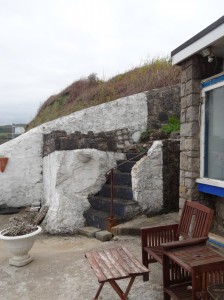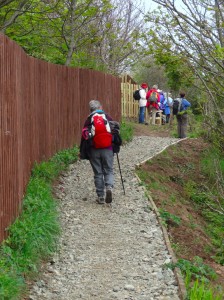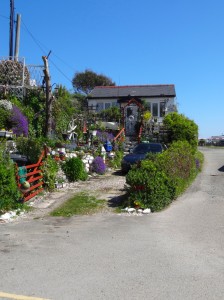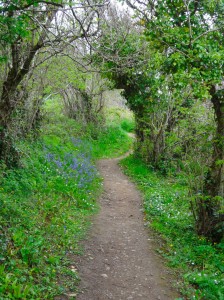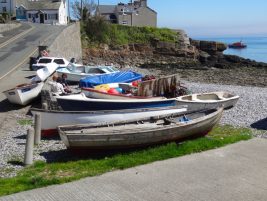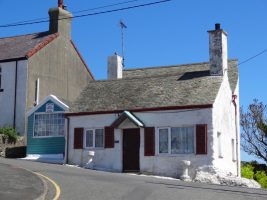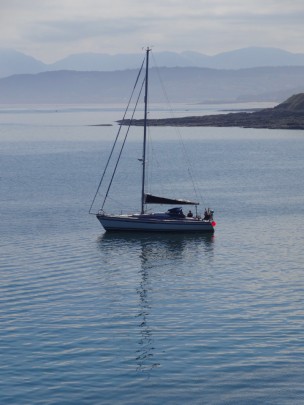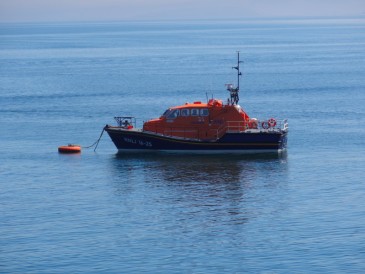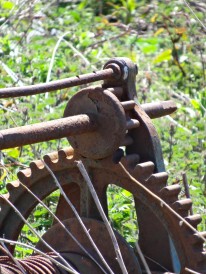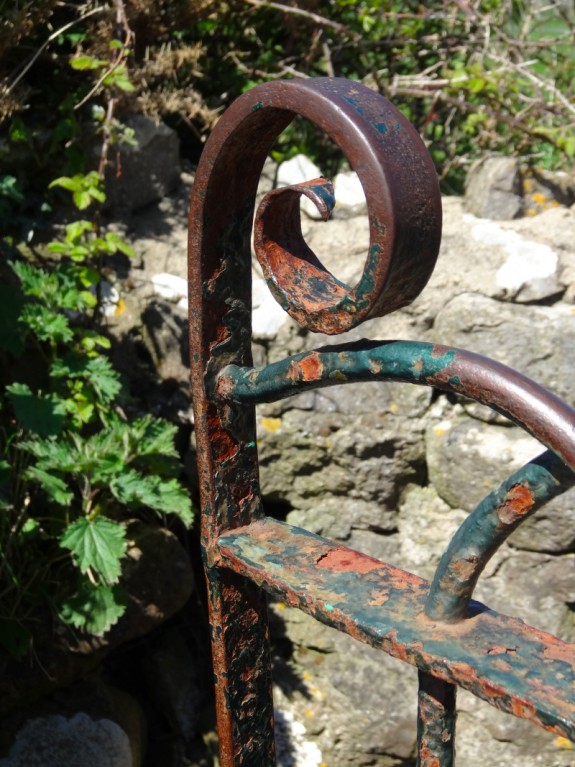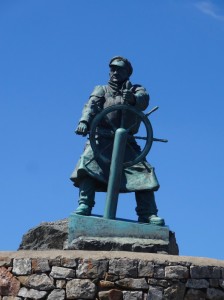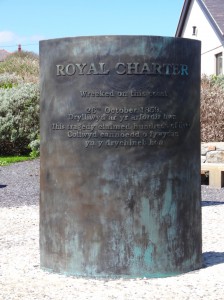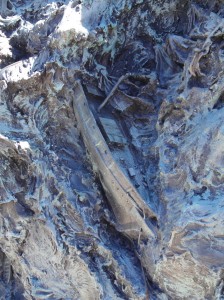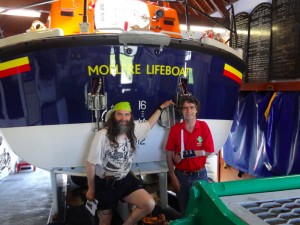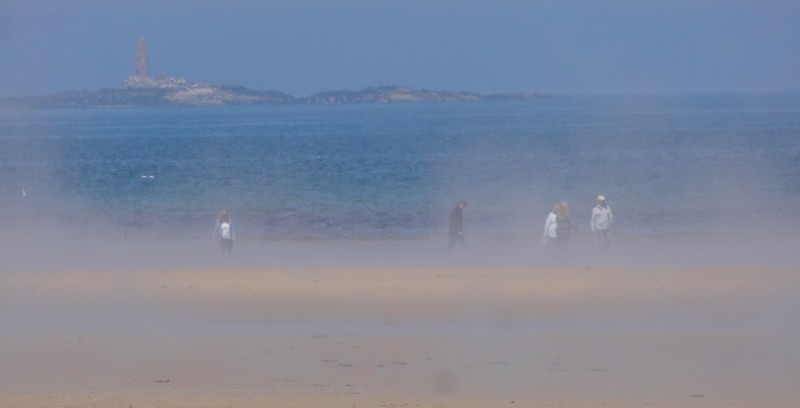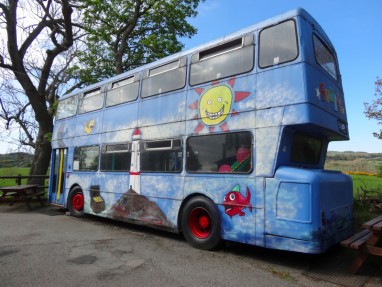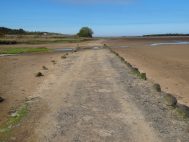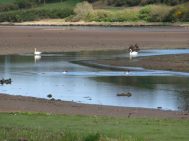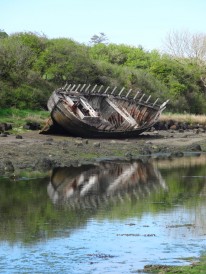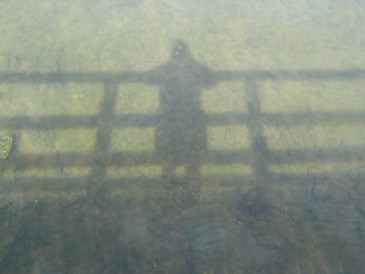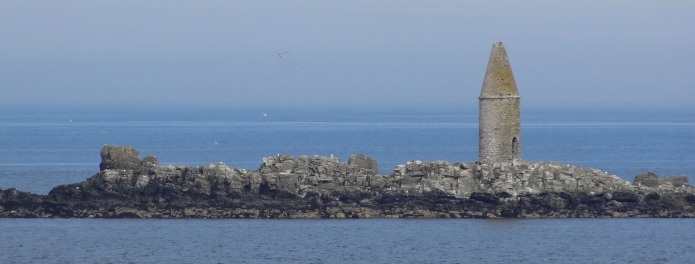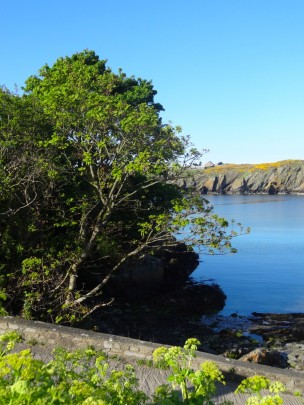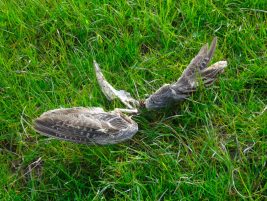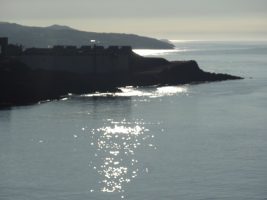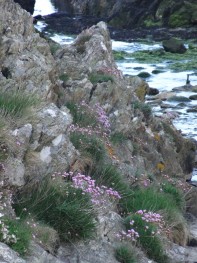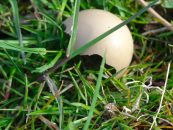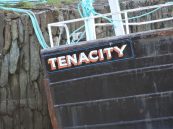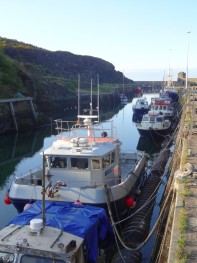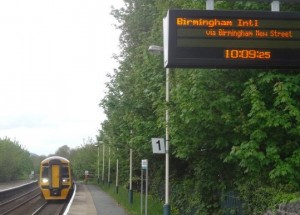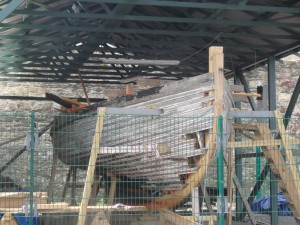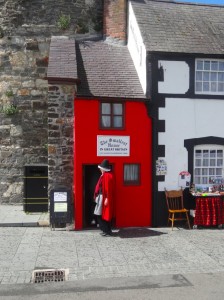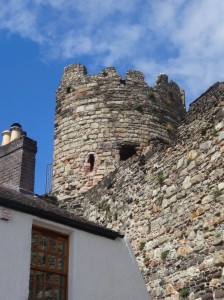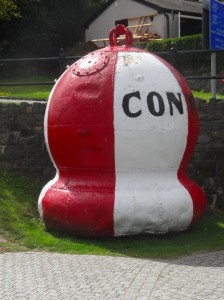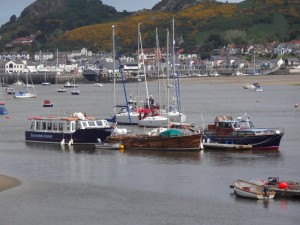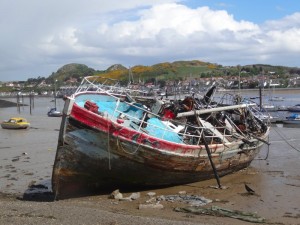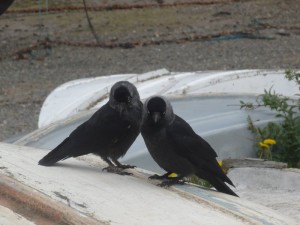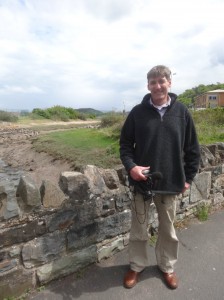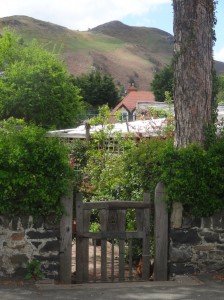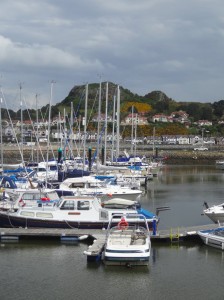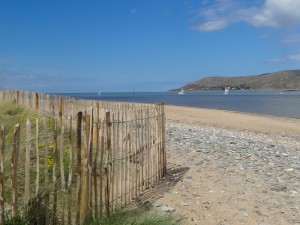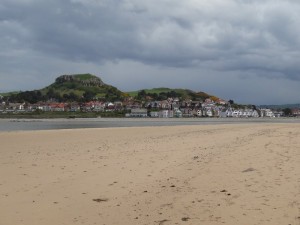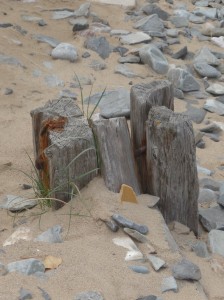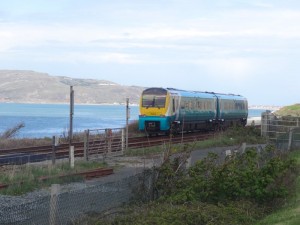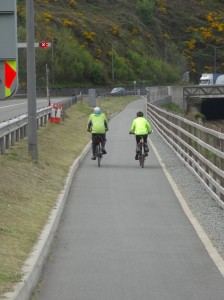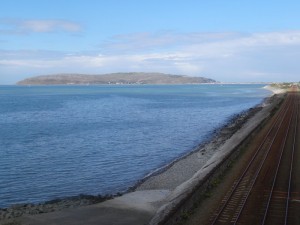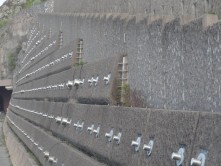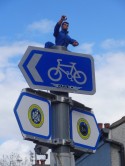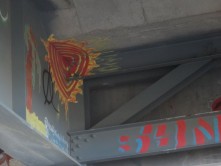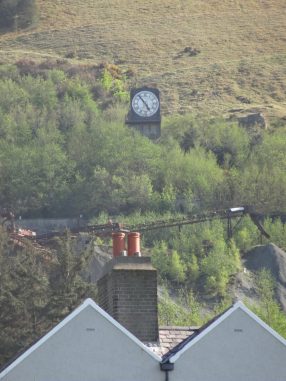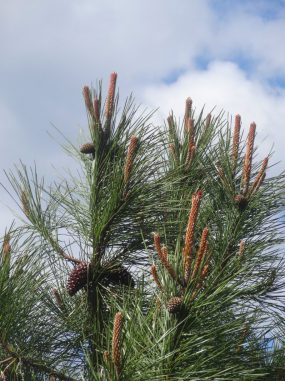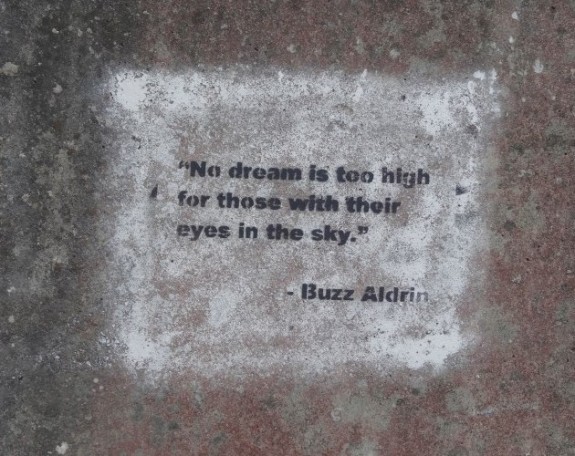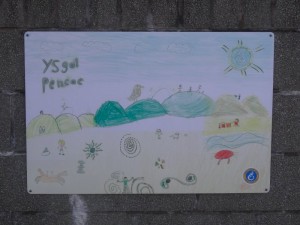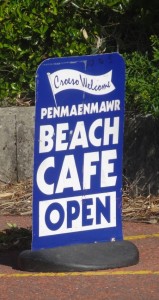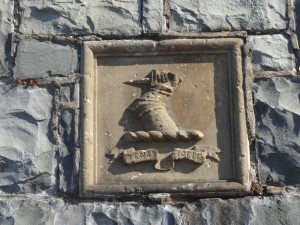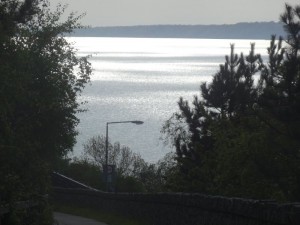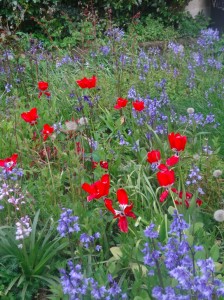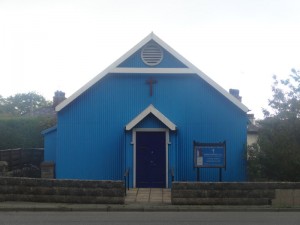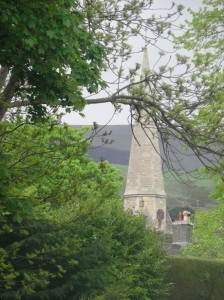onto Anglesey, island of druid and prayer; a missing cafe, a priory dovecote, a wave-lashed lighthouse and a blocked path
18 May 2013: blog | flickr | audio | map | data
miles walked: 21
miles completed: 323.3
miles to go: 737
I arrived at Menai Bridge by bus and started the route where I had finished it the previous night outside The Bridge Inn on the Anglesey end of the bridge. There is a tiny garden here with a seat and a plaque; it was made to commemorate the children who died in the Aberfan in 1966.
Menai Bridge is definitely not down at heel. No boarded up shops, but an interior design studio, art gallery, and posh restaurants. The Coast Path follows small streets through the town, with occasional small grassed areas overlooking the Menai Straits.
Looking back to the bridge, it is an amazing feat of engineering, but maybe more amazing are the bus drivers who go across it day by day. Each carriageway goes under its own arch, and when I say ‘carriageway’ of course when Telford designed it it was for carriages. A modern bus is a lot wider than a 19th-century horse-drawn carriage. To get through the arch the bus has to first come to a complete stop; I think this must be to allow the normal slight side-to-side swaying to decay. The traffic builds up behind. Then, very slowly it inches forward, the wing mirrors nearly scraping the stone, then, like a snake wriggling from its skin, once the wing mirrors are through the driver speeds up, until the bus reaches the second tower and the process starts again.
The Coast Path follows the main road towards Beaumaris. The road has few cars and is pleasant, with views across the straits, so much so that when the Coast Path takes a more minor road inland, I wonder why, given it normally hugs the coast so closely. However, I can imagine that in summer the now tolerably busy coast road will be tail-to-tail with cars.
For a while, the small road leads through semi-suburban-style village, with houses or close hedgerow on both sides, adding to my wonder as to why the path ever left the coast road with its open views up and down straits and across to Snowdonia. But then, the houses on the seaward side ended and gave way to open fields and open stunning panorama, from the Great Orme to the valleys cutting into the mountains, and I decided the path planners perhaps did know what they were doing.
For a short while the path leads off the road past bluebell woods and then into a veritable Hampton Court Maze of gorse land. Instead of neatly cut hedges the gorse branches near meet across the way, pulling and tearing at you like a Sleeping Beauty forest, and underfoot, instead of manicured grass, sinking boot-churned mud that threatens to swallow you. I have been wearing sandals instead of boots since the day from Mostyn to Abergele when my ankles swelled, and for the first time since then I thought that maybe boots had their advantages.
Unlike the ancient unicursal mazes and spirals, this is a land of crossing pathways, and instead of an Ariadne thread, occasional (too occasional) marker posts to tell you that this is the right clinging narrow track amongst many. In short, although maybe half a mile across or less, the sort of place that as a child I would have died for.
Coming down into Beaumaris (Biwmares) the road passes fern-lined under a railway bridge and I am struck again that while the camera can ‘capture’ sights and the recorder sounds, the smells are still held only in your memory, and so hard to express unless you have experienced them yourself: the dark dank earth smell of the fern; the almost sickly rich, honey-sweet gorse; the sharp aromatic wild garlic; and even, a few days before, along the A55 leading from Conwy to Penmaenmawr, the pungent peaty sweat-sour rubber on tarmac.
I find it hard to bring a smell to mind, in the way I can a sight or sound, as if my own memories are as limited as tape and celluloid, but when you smell one again – the sheer emotional force… In psychological terms, recall is poor, but recognition instant. Smell is very old, pre-dating trilobites with their early eyes. Smell links directly to ancient parts of our brains, that we share even with reptiles; a dinosaur in our minds. Yet, perhaps because so primitive, hard to explicitly grasp.
I have noticed too that while in dreams I see and hear, I do not smell or taste. Perhaps these are too deeply buried; do dinosaurs dream?
I guess perfumers have a vocabulary for scents, as wine lovers do for taste. Does this help with recall, as having more colour names does for recall of colours? Do cultures that have fewer colour words dream in monochrome and do perfumers dream in scent?
Beaumaris culture sits low on the north eastern edge of town, out of sight in the first approach. Multicoloured houses across the water remind me of Tobermory. I am hungry by now and looking forward to revisiting the seaside café with its own tide-filled crab pool. When the girls were little we camped on Anglesey in our old Type 2 VW campervan, and visited Beaumaris. The café hired out crab lines, bait and pails, so that children could go crabbing, before emptying the crabs back into the water for the next child.
So I pass by inviting beach front bistros, and press on to the far side of town beyond the large car parks in front of the castle, only to find the café fenced off, its roof tiles missing and the pool drained. Maybe the bottom had fallen out of the crabbing market, maybe it was too far from the centre of Beaumaris, maybe simply not the style of establishment that is attractive to heritage visitors.
So instead I have lunch at ‘Simply Snacks‘, nearly opposite the castle entrance, simple but beautifully decorated, with basic but well-prepared food, definitely café not ‘caf’. I love them all, from the chintz ‘ye olde tea room’, to wine-bar-style glass and steel, or natural wood and organic carrot cake establishments, but I fear the Formica-tabled traditional sea-front café may soon be a thing of the past. Strange, in Italy, it is expected to find the best food in the most basic surroundings, yet in Britain, while not as focused on the ‘experience’ as the French, still ‘appearances matter’.
This makes me think about Apple. In the early days Apple combined strength of design at all levels (well nearly all, the early Apple mouse was always an ergonomic disaster), innovative appearance with the best user interface. Perhaps even then the latter was inherited from their licensing of Xerox Star design. Certainly of latter years, not helped when they sacked nearly all their UI research team more than ten years back, and rather like ‘French‘ cuisine (not regional French cooking) has lost sight of the food in search of ambience, Apple have lost sight that this is a computer, which needs to be used to do things, not just an ‘experience’ and a brand.
This is certainly very relevant currently. If I walk for any period of time, in classic fashion, with hands pushed into rucksack straps, a spot behind my shoulder blade seizes in a knot. The same thing happens when I drive. It is the long-term impact of the ergonomically disastrous Apple trackpad, sadly emulated by others, which ignores the basic fact that we have an opposable thumb.
Passing Beaumaris Castle, I note that the green area below its walls, which would once have been the killing fields where attackers would fall cut down by arrows from both sides, is now a children’s playground – swords to ploughshares albeit after 800 years.
***** TBC *******
Beyond Beaumaris the path keeps close to the coast, along grassy fields or pebble and sand beaches below red earth banks, passing the occasional cottage, farm and dilapidated boat house. The earth banks are scoured by the powerful tide race of the Straits, sometimes cut into caves or even a sugar loaf hummock stranded on the shoreline.
A quarry and long abandoned works blocks the way along the shore, chimney and walls still standing, remnants of past industry. The Coast Path cuts inland towards Penman Priory, ruins dating back to the 13th century when the Augustinian Priory was built on the site of an older Celtic institution. The Christian roots lie deep alongside older settlements and chambered tombs, the island where Roman legions slaughtered druids amongst the oak groves.
At Bangor Cathedral the day before I’d seen a notice about a prayer walk all around Anglesey. It was to be done on a single day with different groups tackling different sections, so that prayer would surround the whole island. I’d mistaken the dates and emailed the contact thinking I’d be passing a group during the day, only to find that I was out by a month, I’d looked at dates, but not month!
The most impressive part of the Priory ruins is the largely intact dovecot, a corbeled roof structure, its internal walls Swiss cheese punctured by innumerable nesting niches. Directly below the circular light from the roof apex, a strange-stepped pillar in the centre rises, from which a ladder could be used to bring in the white-breasted harvest.
The Path leads along a lane north, back towards the sea and the Trwyn Du lighthouse, ‘No Passing Landward’ written on its side, with another red buoy-shaped structure nearby marking more treacherous undersea rocks. The seas break over the latter as I watch, but photos inside the small café at the point show wild waves breaking almost the height of the light itself.
There are a young girl and man inside who are interested in the walk and who, happily, are more observant than me, as I almost left my bag with money, cards, etc., as I left.
After this there is an inland section running initially almost back the way I’d come, sometimes along small lanes, and sometimes footpaths across moorland, through woods and across fields. Looking back the tip of Trwyn Du is visible for some time peeking above cliff top and hedgerow, before it eventually drops out of sight.
I pass signs for a secluded yurt holiday, and telling me that Ramblers have improved the path. To sea large tankers stand nearly motionless. I later learn that they weigh anchor there as it is cheaper than berthing at Liverpool. The crews, from all over the world, sometimes come ashore in the villages further along the North Anglesey coast. Thinking back, I guess this may not always be strictly legal, as not all will have entry visas.
Along the paths I notice that a light turquoise is a popular colour for metal work and even the rope holding rocks to close gates. Much of the land is part of Plas Newydd, maybe it is a favourite colour of the owner.
I think the frequent alternation of path and lane confused my sense of progress. I knew that ahead was Bwrdd Arthur (Arthur’s table), a hill with an old fort on top, and was sure that I was almost there, only to realise it had been another hill and I still had far to go. When eventually I did pass it, I had a moment of confusion as the Path leads through a farmyard with no indication of the way to go. After eventually deciding from the map that this was definitely right, I found, a short way on, a footpath sign, and also, somewhat weirdly, found the hillside was ‘Bryn Offa‘, as if a flashback to two weeks ago.
So all good, and I was on nearly the last stretch down towards Red Wharf Bay, when, disaster, the way ahead is blocked by red plastic fencing and a sign ‘Danger Keep Out’, ‘Footpath Closed’ – there had been a landslip and the way ahead was blocked.
The way back to the last major road was a long way, so I took the only path that seemed possible, a small footpath that led up across the hillside. The way narrowed as it entered woods, and brambles and nettles began to crowd close. It became increasingly difficult, brambles began to cut my bare legs, but I was committed, and then … another small sign perched in a bucket, ‘no public footpath, go back’.
I could see that the way beyond became even more choked, but I had come so far and the time was getting late, so I ignored the sign and pressed on. Now there was no protection, nettles stung and brambles tore, until, at last, it broke free into a small field. The field was fenced all around, except for one gate that led into a small yard, which itself led out onto the road.
I came into the yard and was greeted by a middle-aged couple, "You can’t come through here; there’s a sign; go back".
*************************************************
I had been told not to expect much of signage in North East Wales as tourism was seen as an irrelevant distraction in an industrial or post-industrial area. However, while the signage for the actual path could sometimes be sketchy, the local history signage in the North East had been exemplary, beautifully shaped metal signs with often unexpected glimpses of past times. The waterside walks, designed less for the long distance walker and more for the resident, were also well laid out.
I was now in Anglesey, where tourism is a major facet of the economy, with, since the closing of the Holyhead aluminium smelting plant, only the air force base as a rival.
At Red Wharf Bay I saw the first of the many beach information signs around the coast of Anglesey. I guess there was probably one at Beaumaris too, but I’d missed it amongst the crowds. Here, at the car park on the east end of Red Wharf Bay it was unmissable, a blue metal, three-sided sign rising above the cars.
Each side had an upper and a lower section. On one side was a map of all of Anglesey, useful, I guess, to get an overview, with information about Anglesey in general. Another had a map of Red Wharf Bay itself, dedicated solely to telling you where you were NOT allowed to walk a dog, and also a copy of the local beach by-laws. The final side had a large photograph of Red Wharf Bay, which of course I could see by turning round. The production values were excellent, it had clearly not been cheap; but absolutely nothing about the nature, history or culture, just prohibitions and a superfluous photograph.
Throughout the walk I had been assiduously photographing the signage I saw on the way, and I similarly photographed this sign, but it was the last of these beach signs that I bothered to take as all were effectively identical. It felt such a waste, impressive I’m sure when they were launched, but utterly useless.
The Coast Path leads round the bay, and I was walking along the sands. However, the tide was out and the whole bay a wide expanse of sand. So instead of skirting the shoreline I set out directly across the bay, which appeared, from the map and from what I could see to be firm sand except for a small channel that ran across the middle of the bay. I knew I might have to trace it back to the shoreline if it was impassable, but thought it was worth a try as I was late and it would save me some time, and also because it is just lovely to march out across the sand.
I was so glad that I was walking in sandals not boots. Although I could have taken boots off and walked barefoot, it was so easy to just wade through the shallow channel with sandals and shorts, the water coming barely above my knees.
On the far side of the bay it was just a short way around the back of a small static caravan site, round a headland, and into Benllech, where the Sea View Guest House sat on the small sea front. Keith (I think) directed me across the road to the Bay Café, a lovely restaurant with picture windows overlooking the sea.
I was just staying one night in this B&B and then taking the bus back to Llanfairfechan the next evening from Amlwch, so I needed only a change of clothes and a toothbrush in my day bag to make it an overnight one. Although with chargers, iPad, and the large, albeit light, recording box for the dot.rural narrative project, my rucksack was far from minimal, still there is something satisfying in having all you need in a small rucksack.

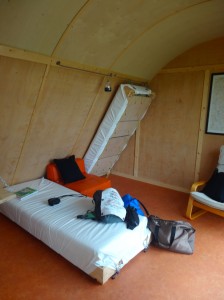
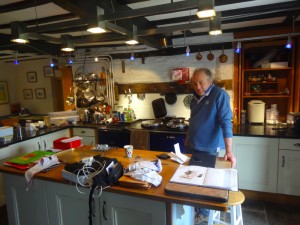
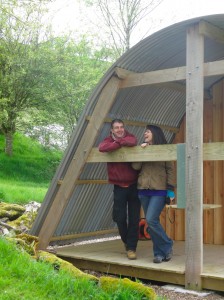
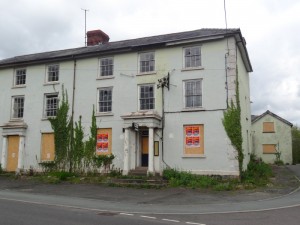 Too soon I have to take my leave as I need to get up to
Too soon I have to take my leave as I need to get up to 